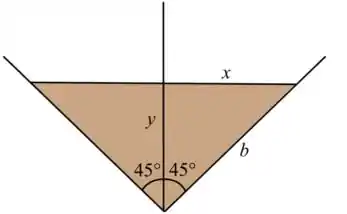Modify Prob. P10.18, the 908 V channel, to let the surface
be clean earth, which erodes if the average velocity exceeds 6 ft/s. Find the maximum depth that avoids erosion.
The slope is still 3 m per km.
Passo 1
Saaaalve, tranquilo? Vamos lá resolver mais uma questão juntos?! 😊
Considere o canal de aço pintado em forma de V com um ângulo de

Passo 2
Calcule a área do canal:
Onde, é a profundidade do canal e é o ângulo
Calcule o perímetro molhado:
Passo 3
Calcular o raio hidráulico:
Substituindo valores
Passo 4
Declive
Para a terra limpa, o fator de Manning é ,Calcule a velocidade média:
Assim, a velocidade é dada como,
Substituindo valores
Portanto, a profundidade máxima que evita a erosão é .